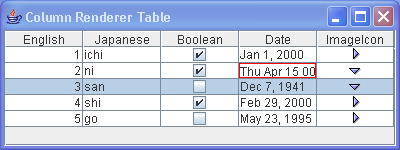Use model to control the Editable Columns

/*
Definitive Guide to Swing for Java 2, Second Edition
By John Zukowski
ISBN: 1-893115-78-X
Publisher: APress
*/
import java.awt.BorderLayout;
import java.util.Date;
import javax.swing.Icon;
import javax.swing.ImageIcon;
import javax.swing.JFrame;
import javax.swing.JScrollPane;
import javax.swing.JTable;
import javax.swing.table.AbstractTableModel;
import javax.swing.table.TableModel;
public class EditableColumn {
public static void main(String args[]) {
TableModel model = new AbstractTableModel() {
Icon icon1 = new ImageIcon("TreeCollapsed.gif");
Icon icon2 = new ImageIcon("TreeExpanded.gif");
Object rowData[][] = {
{ new Integer(1), "ichi", Boolean.TRUE,
new Date("01/01/2000"), icon1 },
{ new Integer(2), "ni", Boolean.TRUE,
new Date("04/15/1999"), icon2 },
{ new Integer(3), "san", Boolean.FALSE,
new Date("12/07/1941"), icon2 },
{ new Integer(4), "shi", Boolean.TRUE,
new Date("02/29/2000"), icon1 },
{ new Integer(5), "go", Boolean.FALSE,
new Date("05/23/1995"), icon1 }, };
String columnNames[] = { "English", "Japanese", "Boolean", "Date",
"ImageIcon" };
public int getColumnCount() {
return columnNames.length;
}
public String getColumnName(int column) {
return columnNames[column];
}
public int getRowCount() {
return rowData.length;
}
public Object getValueAt(int row, int column) {
return rowData[row][column];
}
public Class getColumnClass(int column) {
return (getValueAt(0, column).getClass());
}
public void setValueAt(Object value, int row, int column) {
rowData[row][column] = value;
}
public boolean isCellEditable(int row, int column) {
return (column != 4);
}
};
JFrame frame = new JFrame("Column Renderer Table");
JTable table = new JTable(model);
JScrollPane scrollPane = new JScrollPane(table);
frame.getContentPane().add(scrollPane, BorderLayout.CENTER);
frame.setSize(400, 150);
frame.setVisible(true);
}
}
Related examples in the same category